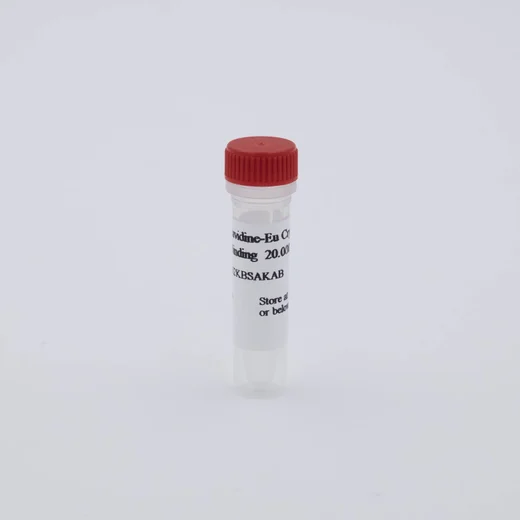

HTRF Streptavidin-Eu cryptate Kinase Binding, 1,000 Assay Points






This Streptavidin-Eu cryptate is used in the HTRF® Kinase Binding format, in combination with an N-terminal-biotinylated Kinase and red-fluorescent tracers.
For research use only. Not for use in diagnostic procedures. All products to be used in accordance with applicable laws and regulations including without limitation, consumption & disposal requirements under European REACH regulations (EC 1907/2006).
Product information
Overview
The Streptavidin was labeled with Eu crypate. Biotin binds to Streptavidin with high affinity (Ka=10^15 M-1). This binding is rapid and stable, making it an ideal choice for use in the biochemical HTRF Kinase Binding platform.
Specifications
| Assay Points |
1000
|
|---|---|
| Assay Target Type |
Fluorescent reagent
|
| Assay Technology |
HTRF
|
| Brand |
HTRF
|
| Quantity |
1
|
| Therapeutic Area |
Metabolism/Diabetes
Neuroscience
Oncology & Inflammation
|
| Unit Size |
1,000 Assay Points
|
Video gallery


How it works
Kd determination assay principle
The binding of the tracers is detected in a sandwich assay format using Streptavidin labeled with Europium Cryptate (donor), which binds to the N-terminal biotinylated-Kinase, and a red fluorescent tracer labelled with d2 (acceptor). The detection principle is based on HTRF® technology. The HTRF ratio (665/620) will increase upon the addition of more of the tracer, and will saturate depending on the dissociation constant (Kd) of the tracer to the N-terminal biotinylated-Kinase.

Kd determination assay protocol
Saturation binding experiments on the three tracers (i.e. Staurosporine-Red, Dasatinib-Red, and Sunitinib-Red) can be run in 96- or 384-well plates (20 µL final volume). First, a dilution series of tracer ranging between 0 and 1 µM in the Kinase Binding Buffer is prepared in a 96-well non-binding plate. NExt, 5 µL of Kinase Binding Buffer are dispensed into the final 96- or 384-well plate. Then 5 µL of N-terminal biotinylated-Kinase are added, followed by 5 µL of Streptavidin Eu-cryptate. Finally 5 µL of the red tracer solution are added. The HTRF ratio is measured after 1 H of incubation.

IC50/Ki determination assay principle
Principle of HTRF® Kinase binding assay (IC50/Ki-determination). The binding of the tracers is detected in a sandwich assay format using Streptavidin labeled with Europium Cryptate (donor), which binds to the tagged Kinase, and a red fluorescent tracer labelled with d2 (acceptor). The detection principle is based on HTRF® technology. The HTRF ratio (665/620) will increase upon the addition of more of the tracer, and will saturate depending on the dissociation constant (Kd ) of the tracer to the tagged kinase. When an inhibitor of the kinase is added, the tracer will be displaced and the HTRF signal will disappear, depending on the dose.

IC50/Ki determination assay protocol
Pharmacological evaluation of inhibitors of interest can be run in 96- or 384-well plates. First, a dilution series of inhibitor ranging between 40 µM and 0.23 nM is prepared, and 5 µL of each concentration are dispensed into the plate. Next, 5 µL of tagged-Kinase are added, followed by 5 µL of Streptavidin Eu-cryptate. Finally, 5 µL of tracer solution are added, prepared at 4x the final concentration. The HTRF ratio is measured after 1H of incubation. Analyses of the data give typical dose response curves ranging between 10 µM and 56 pM, enabling an evaluation of the IC50/Ki values for the inhibitor of interest.

Assay validation
Saturation Binding KIT-Biotin
A typical saturation binding experiment is performed using final tracer concentrations between 0 and 250 nM, and measuring total- and non-specific binding signals. Subtracting the non-specific from the total binding signal gives the specific signal, which can be analysed to give the Kd. Here an example is shown where the best tracer for inhibitor studies proved to be Sunitinib-Red, with a Kd of 22 nM on 5 nM KIT-BTN.

Competitive Binding KIT-Biotin
Dose response curves of various known kinase inhibitors (Staurosporine, Dasatinib, PP2, Imatinib, Tozasertib, Sunitinib, Gefitinib, and Sorafenib) were measured using Sunitinib-Red at its Kd (22 nM) on 5 nM KIT-BTN. Dasatinib and Sunitinib showed high potencies, in good correlation with literature values. As expected, Gefitinib does not bind to KIT.

Resources
A Bruton Tyrosine Kinase (BTK) case study
PROteolysis Targeting Chimeras (PROTACs) are one of the latest trending tools used in...
This guide provides you an overview of HTRF applications in several therapeutic areas.

SDS, COAs, Manuals and more
Are you looking for technical documents for this product. We have housed them in a dedicated section., click on the links below to explore.


How can we help you?
We are here to answer your questions.






























